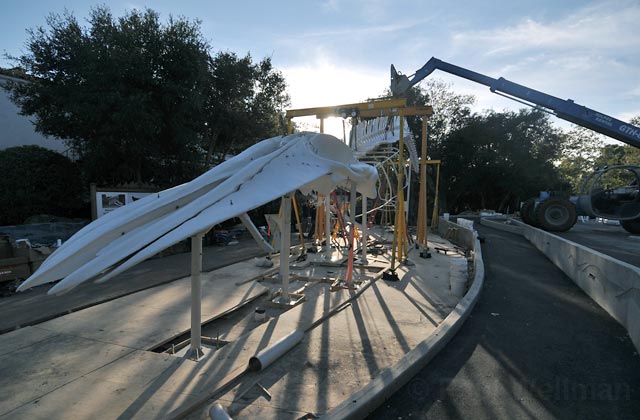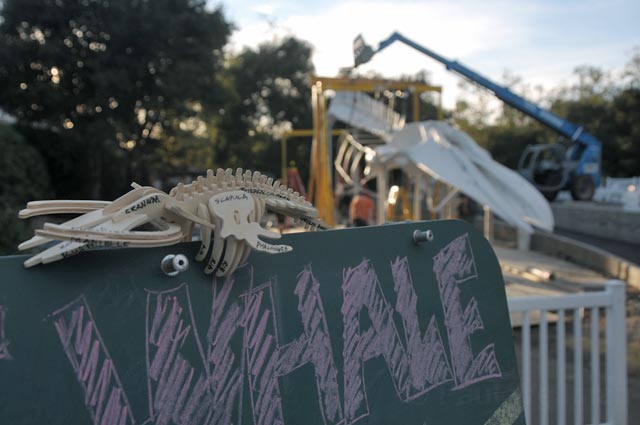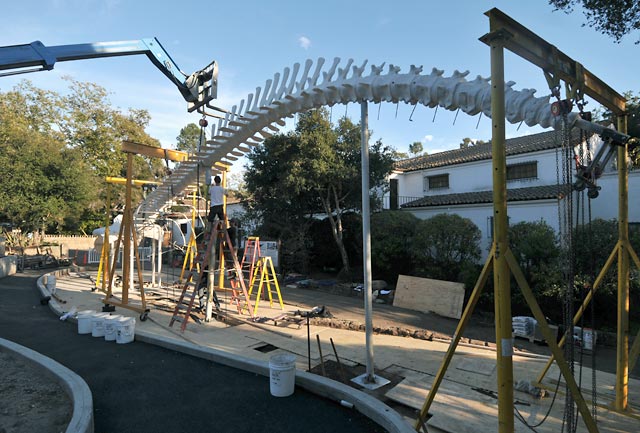Blue Whale Skeleton Returns
Public Invited to Watch as It's Rebuilt at Natural History Museum

After nine months of restoration and refurbishment, Santa Barbara Natural History Museum’s blue whale “Chad” is back home — and better than ever.
For Paul Collins, curator of Vertebrate Zoology, that’s a sigh of relief.
“It’s really been an icon for the museum and the community,” Collins said. “This time, it’ll be a completely new exhibit.”
For the next week, more than two dozen specialists will be assembling the 7,600 pounds of bone that make up Chad, who is one of only five fully articulated blue whale skeletons on display in the United States. This time around, the whale will be installed “in a more anatomically correct position,” with a bend in the back section as if three-quarters of the species were under water.

“It is a beautiful thing to see the tail fluke or the top of a blue whale as it is swimming in the ocean,” Collins said.
The public is welcome to watch the articulation, which hasn’t happened since the first specimen arrived in 1983. “For some, it’s a once-in-a-lifetime opportunity,” said museum spokesperson Easter Moorman.
The composite, which is made up of bones taken from four specimens, will also include a new skull (weighing 4,500 pounds) harvested from two stranded blue whales retrieved off Hobson Beach in Ventura. Collins was excited to comment on the restoration, which has come from the bottom up as workers have poured new foundation, installed new piping within the vertebral column, and engineered a structure system that will make it safe for the public to get in and around.
In March, the blue whale “migrated” to Academy Studios in Novato, CA, where the whale was restored because of severe weathering and tampering by visitors. Just weeks before the whale was disassembled for restoration in March, museum officials deemed the whale was too fragile, making it unsafe for visitors to walk in or around.
While in Novato, Production Manager Jim Slater and engineers at Academy Studios have gone through the delicate process of restoring the worn-down whale by cleaning, repairing cracks, and applying two layers of marine grade penetrating epoxy — used in boat making — and adding a thick sealing layer so that the whale will be able to survive harsh weather conditions and be easier to maintain.
“We’re going to make sure it stays up outdoors,” Slater said. “It’s exciting to see that after all this hard work, it’s finally all coming together.”
The skeleton — which is of a young male blue whale that washed ashore near Vandenberg Air Force Base in August 1980 — has received two similar, major repairs in the decades since it was installed.

About 98 percent of the skeleton is actual bone while 2 percent of the pieces have been replicated in castings.
Michelle Berman, assistant curator of Vertebrate Zoology, helped with the gathering of the new skull, and attended Wednesday morning’s delivery — just hours before she gave birth to her third child.
“You make all these decisions along the way, and to see it come together … It’s amazing,” Berman said.
“It’s two big deliveries for her today,” Collins joked.
Other improvements will be made to the exhibit, Collins explained, including updated signs, lighting, and landscaping. Visitors will also be able to once again tour in and around the whale.
The museum was able to raise the $500,000 needed for the restoration through the Buy-A-Bone fundraising effort. According to Moorman, there are still bones available for donations to the cause. Any further funds raised will be used to maintain the exhibit.
Collins hopes that the blue whale will be ready for the public to fully tour by December 18.



